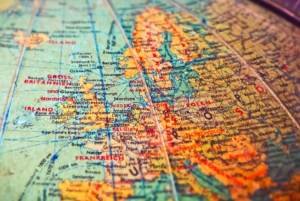16.8: Global Leadership
- Page ID
- 47189
\( \newcommand{\vecs}[1]{\overset { \scriptstyle \rightharpoonup} {\mathbf{#1}} } \)
\( \newcommand{\vecd}[1]{\overset{-\!-\!\rightharpoonup}{\vphantom{a}\smash {#1}}} \)
\( \newcommand{\dsum}{\displaystyle\sum\limits} \)
\( \newcommand{\dint}{\displaystyle\int\limits} \)
\( \newcommand{\dlim}{\displaystyle\lim\limits} \)
\( \newcommand{\id}{\mathrm{id}}\) \( \newcommand{\Span}{\mathrm{span}}\)
( \newcommand{\kernel}{\mathrm{null}\,}\) \( \newcommand{\range}{\mathrm{range}\,}\)
\( \newcommand{\RealPart}{\mathrm{Re}}\) \( \newcommand{\ImaginaryPart}{\mathrm{Im}}\)
\( \newcommand{\Argument}{\mathrm{Arg}}\) \( \newcommand{\norm}[1]{\| #1 \|}\)
\( \newcommand{\inner}[2]{\langle #1, #2 \rangle}\)
\( \newcommand{\Span}{\mathrm{span}}\)
\( \newcommand{\id}{\mathrm{id}}\)
\( \newcommand{\Span}{\mathrm{span}}\)
\( \newcommand{\kernel}{\mathrm{null}\,}\)
\( \newcommand{\range}{\mathrm{range}\,}\)
\( \newcommand{\RealPart}{\mathrm{Re}}\)
\( \newcommand{\ImaginaryPart}{\mathrm{Im}}\)
\( \newcommand{\Argument}{\mathrm{Arg}}\)
\( \newcommand{\norm}[1]{\| #1 \|}\)
\( \newcommand{\inner}[2]{\langle #1, #2 \rangle}\)
\( \newcommand{\Span}{\mathrm{span}}\) \( \newcommand{\AA}{\unicode[.8,0]{x212B}}\)
\( \newcommand{\vectorA}[1]{\vec{#1}} % arrow\)
\( \newcommand{\vectorAt}[1]{\vec{\text{#1}}} % arrow\)
\( \newcommand{\vectorB}[1]{\overset { \scriptstyle \rightharpoonup} {\mathbf{#1}} } \)
\( \newcommand{\vectorC}[1]{\textbf{#1}} \)
\( \newcommand{\vectorD}[1]{\overrightarrow{#1}} \)
\( \newcommand{\vectorDt}[1]{\overrightarrow{\text{#1}}} \)
\( \newcommand{\vectE}[1]{\overset{-\!-\!\rightharpoonup}{\vphantom{a}\smash{\mathbf {#1}}}} \)
\( \newcommand{\vecs}[1]{\overset { \scriptstyle \rightharpoonup} {\mathbf{#1}} } \)
\( \newcommand{\vecd}[1]{\overset{-\!-\!\rightharpoonup}{\vphantom{a}\smash {#1}}} \)
\(\newcommand{\avec}{\mathbf a}\) \(\newcommand{\bvec}{\mathbf b}\) \(\newcommand{\cvec}{\mathbf c}\) \(\newcommand{\dvec}{\mathbf d}\) \(\newcommand{\dtil}{\widetilde{\mathbf d}}\) \(\newcommand{\evec}{\mathbf e}\) \(\newcommand{\fvec}{\mathbf f}\) \(\newcommand{\nvec}{\mathbf n}\) \(\newcommand{\pvec}{\mathbf p}\) \(\newcommand{\qvec}{\mathbf q}\) \(\newcommand{\svec}{\mathbf s}\) \(\newcommand{\tvec}{\mathbf t}\) \(\newcommand{\uvec}{\mathbf u}\) \(\newcommand{\vvec}{\mathbf v}\) \(\newcommand{\wvec}{\mathbf w}\) \(\newcommand{\xvec}{\mathbf x}\) \(\newcommand{\yvec}{\mathbf y}\) \(\newcommand{\zvec}{\mathbf z}\) \(\newcommand{\rvec}{\mathbf r}\) \(\newcommand{\mvec}{\mathbf m}\) \(\newcommand{\zerovec}{\mathbf 0}\) \(\newcommand{\onevec}{\mathbf 1}\) \(\newcommand{\real}{\mathbb R}\) \(\newcommand{\twovec}[2]{\left[\begin{array}{r}#1 \\ #2 \end{array}\right]}\) \(\newcommand{\ctwovec}[2]{\left[\begin{array}{c}#1 \\ #2 \end{array}\right]}\) \(\newcommand{\threevec}[3]{\left[\begin{array}{r}#1 \\ #2 \\ #3 \end{array}\right]}\) \(\newcommand{\cthreevec}[3]{\left[\begin{array}{c}#1 \\ #2 \\ #3 \end{array}\right]}\) \(\newcommand{\fourvec}[4]{\left[\begin{array}{r}#1 \\ #2 \\ #3 \\ #4 \end{array}\right]}\) \(\newcommand{\cfourvec}[4]{\left[\begin{array}{c}#1 \\ #2 \\ #3 \\ #4 \end{array}\right]}\) \(\newcommand{\fivevec}[5]{\left[\begin{array}{r}#1 \\ #2 \\ #3 \\ #4 \\ #5 \\ \end{array}\right]}\) \(\newcommand{\cfivevec}[5]{\left[\begin{array}{c}#1 \\ #2 \\ #3 \\ #4 \\ #5 \\ \end{array}\right]}\) \(\newcommand{\mattwo}[4]{\left[\begin{array}{rr}#1 \amp #2 \\ #3 \amp #4 \\ \end{array}\right]}\) \(\newcommand{\laspan}[1]{\text{Span}\{#1\}}\) \(\newcommand{\bcal}{\cal B}\) \(\newcommand{\ccal}{\cal C}\) \(\newcommand{\scal}{\cal S}\) \(\newcommand{\wcal}{\cal W}\) \(\newcommand{\ecal}{\cal E}\) \(\newcommand{\coords}[2]{\left\{#1\right\}_{#2}}\) \(\newcommand{\gray}[1]{\color{gray}{#1}}\) \(\newcommand{\lgray}[1]{\color{lightgray}{#1}}\) \(\newcommand{\rank}{\operatorname{rank}}\) \(\newcommand{\row}{\text{Row}}\) \(\newcommand{\col}{\text{Col}}\) \(\renewcommand{\row}{\text{Row}}\) \(\newcommand{\nul}{\text{Nul}}\) \(\newcommand{\var}{\text{Var}}\) \(\newcommand{\corr}{\text{corr}}\) \(\newcommand{\len}[1]{\left|#1\right|}\) \(\newcommand{\bbar}{\overline{\bvec}}\) \(\newcommand{\bhat}{\widehat{\bvec}}\) \(\newcommand{\bperp}{\bvec^\perp}\) \(\newcommand{\xhat}{\widehat{\xvec}}\) \(\newcommand{\vhat}{\widehat{\vvec}}\) \(\newcommand{\uhat}{\widehat{\uvec}}\) \(\newcommand{\what}{\widehat{\wvec}}\) \(\newcommand{\Sighat}{\widehat{\Sigma}}\) \(\newcommand{\lt}{<}\) \(\newcommand{\gt}{>}\) \(\newcommand{\amp}{&}\) \(\definecolor{fillinmathshade}{gray}{0.9}\)- Describe the importance of nurturing global leadership
 Strong leadership is a cornerstone of all successful companies. Strong global leadership begins with a global mind-set. A global mind-set is “characterized by (1) tolerating, accepting, and understanding diversity with an inclusive mind-set; (2) a broad and universal perspective of business; and (3) thinking openly, free from cognitive cobwebs.”[1] People with a global mindset are able to keep an open mind around cultural nuances and make thoughtful decisions with these differences in mind. They are inclusive and understand the benefits of diversity. Global mindset is the foundation of all strong global leaders, as it lays the groundwork for cultural acceptance and understanding.
Strong leadership is a cornerstone of all successful companies. Strong global leadership begins with a global mind-set. A global mind-set is “characterized by (1) tolerating, accepting, and understanding diversity with an inclusive mind-set; (2) a broad and universal perspective of business; and (3) thinking openly, free from cognitive cobwebs.”[1] People with a global mindset are able to keep an open mind around cultural nuances and make thoughtful decisions with these differences in mind. They are inclusive and understand the benefits of diversity. Global mindset is the foundation of all strong global leaders, as it lays the groundwork for cultural acceptance and understanding.
Mindfulness
Mindfulness is a key component to a global mindset and global leadership. Mindfulness is, “a state of mind characterized by heightened awareness of self and the surrounding environment, and to be non evaluative and nonjudgmental in experiencing the present.”[2] Strong leaders need to be aware of their surroundings and understanding of those they interact with. Mindfulness is an invaluable skill for leaders to have in their toolkit. Mindfulness and a global mindset work together to help form a strong global leader. Global leaders interact with a large number of people across multiple cultures. Therefore, in order for global leaders to be successful, they need to be mindful of their surroundings and view the world through a global mindset.
Employee Development
In today’s day and age, international expansion of many companies is becoming the norm. Employees who want to expand their horizons, and gain valuable experience and insight into other cultures may consider taking company assignments in foreign countries. So, how do these employees prepare to be strong global leaders? Training is the best way to nurture global leaders and ensure they have all the knowledge and tools necessary to be successful. International companies who are invested in training global leaders will rapidly reap the benefits.
 A Shrinking World
A Shrinking World
Since technology continues to shrink the world around us, global leaders will continue to play a key role in international expansion. Strong global leaders are able to keep track of cultural differences, as well as compliance and legal concerns, that may differ from one country to the next. Equally as important, successful global leaders are able to seamlessly infuse differing cultures, languages, and personalities to form one strong and cohesive team. When an international company has a unified team, they are better able to quickly and effectively expand. A strong international team also contributes to productivity and profit. If a company has strong global leaders, they are better able to grow and unify the company. Therefore, all international companies should strive to nurture global leadership on their teams.
Sources
Mansoor, Fatima. “The Importance of Developing Global Leaders for Company Growth: Extraordinary Business.” Aepiphanni Business Consulting, October 17, 2017.
- Chandwani, Rajesh, Narendra M. Agrawal, and Ben L. Kedia. “Mindfulness: Nurturing Global Mind-Set and Leadership.” Thunderbird International Business Review 58, no. 6 (2015): 617–25. ↵
- Ibid. ↵
Contributors and Attributions
- Global Leadership. Authored by: Freedom Learning Group. Provided by: Lumen Learning. License: CC BY: Attribution
- Authored by: blackmachinex. Provided by: Pixabay. Located at: pixabay.com/photos/office-people-team-group-woman-4480198/. License: CC0: No Rights Reserved. License Terms: Pixabay License
- Authored by: MichaelGaida. Provided by: Pixabay. Located at: pixabay.com/photos/globe-map-country-borders-old-3383088/. License: CC0: No Rights Reserved. License Terms: Pixabay License


